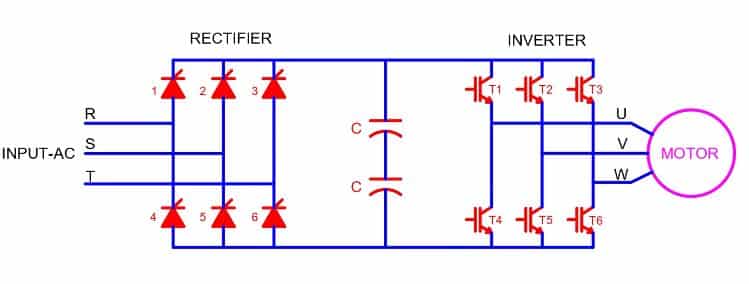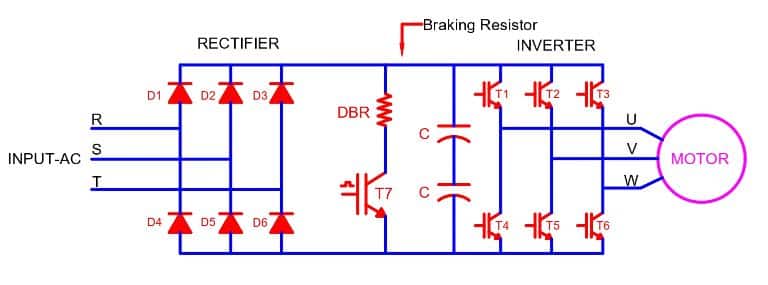In this article, we will discuss AC motor braking methods. VFD is widely used for driving the induction motor. The major braking methods are ramp to stop, coast to stop, dynamic, regenerative & DC injection. There are many applications that require braking for process control.
When a motor functions in the motoring zone, it delivers torque to load for driving it. When we stop the motor keeps on running at a slower speed because of the kinetic energy of the motor. If we dissipate the kinetic energy in the other form of energy, the motor can be stopped immediately.
Thus, the dissipation of the energy after stopping of the motor causes the motor to stop. This process is called the braking of the motor. The amount of braking torque developed depends on the rate of dissipation or re-utilization of the energy.
There are many braking techniques used for an induction motor. In this post, we will discuss the braking technique used for the motor driven by the VFD.
VFD Braking Techniques
The five most commonly used braking methods in VFD are as follows.
- Coast to stop,
- Ramp to stop,
- Regenerative braking and
- Dynamic braking.
- DC Injection braking
Coast to Stop
Coast to stop through VFD means disconnecting the motor from the VFD output voltage and frequency.
This method reduces the VFD frequency to zero in no time. Even after the reduction of frequency to zero, the motor comes at a standstill after some time because of the stored kinetic energy in the motor.
In coast to stop method, the drive immediately reduces the frequency and voltage to zero after giving the stop command to drive. However, the actual motor stopping time depends on the load connected to the motor.
Ramp to Stop
In a ramp-to-stop method, the VFD gradually reduces the voltage and frequency in a ramp-down manner. The ramp-down slope can be set according to the system requirement.
If the load inertia is more, then VFD reduces the motor speed slowly to avoid regeneration in the motor. If the load inertia is small, the VFD reduces the motor speed fast.
Regenerative Braking
When the motor’s actual speed is more than the VFD frequency, the motor acts as a generator. The motor converts its kinetic energy into electrical energy.
Where does this regenerated energy go?
The regenerated energy pumps into the DC bus capacitor bank. It increases the capacitor voltage & the drive trips with over-voltage.
How can this regenerated energy be re-utilized?
However, this way motor braking is not effective. To solve this problem, the regenerated energy needs to feed into the system again. It is possible to feed this energy if the VFD has an active front-end rectifier unit.

The active front-end rectifier functions as an inverter and converts the DC bus voltage in the incoming supply. Thus, it is possible to pump back the energy in the mains.
Dynamic Braking
Dynamic braking is also applied in the case of regeneration braking. There are two methods of braking in the case of regeneration.
- Regenerative braking
- Dynamic braking
In regenerative braking, the generated energy of the motor is back feed in the system for braking. Whereas, in dynamic braking, the generated energy dissipates in the dynamic braking resistor. In the case of regeneration the dc bus voltage increases.

We set the VFD parameter( basically DC bus over-voltage) to switch on the IGBT mounted in parallel to the DC capacitor to take the dynamic braking resistor in the circuit. Thus, the generated energy dissipates in the resistor and the brake applies to the motor.
DC Injection Braking
When the motor keeps on rotating after issuance of the stop command, the motor acts as a generator. The speed of the rotor is more than the synchronous speed and the motor starts pumping energy into the capacitor bank of the VFD.
In the DC injection method, the DC voltage is fed to the stator winding. The stator winding draws current and it produces a magnetic field in the air gap of the motor.
When the rotor rotates in the magnetic field, it produces a voltage in the rotor, and rotor current starts flowing in the rotor. The heat loss (IR) in the rotor is nothing but the kinetic energy of the motor. The rate at which the heat loss takes place decides the braking time.
Read Next:
Very useful i learnt many more